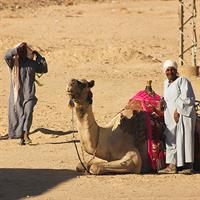Experience The Wahiba Sands

Overview
Nestled in the heart of eastern Oman lies an exquisite gem of mesmerizing landscape, the Wahiba Sands, named for the Bani Wahiba tribe of the region. This vast expanse of sand dunes covers and area of roughly 6,200 square miles. It boasts an array of stunning landscapes, from seas of sweeping, towering dunes to pristine wadis that offer a refreshing respite from the desert sun. Also known as the Sharqiya Sands, the desert’s unique topography and deep cultural heritage make it a fascinating destination that offers a unique experience.
There are a variety of ways to explore the Wahiba Sands. From dune bashing, quad biking, sandboarding, camel riding, desert trekking, sunset drives, and more! So get ready for an adventure when visiting Oman’s stunning Wahiba Sands.


Things to See and Do
One of the most popular activities in the Middle East, and in the Wahiba Sands is adrenaline-pumping dune bashing in a four-wheel drive vehicle. Going up and down the dunes in the seas of sand that stretch for miles on end, makes for a thrilling experience.
Sandboarding down the slopes of the dunes is also very popular and easily available. Another more traditional form of traversing the sand dunes is by riding a camel. This is an activity that has been practiced for centuries, allowing riders to experience the desert environment in a unique and thrilling way. A sunrise or sunset dune tour is a great time to do any of these activities offering pristine conditions and mindblowing views.
Stargazing opportunities are endless. Given the remote location and clear skies, the Wahiba Sands are an ideal spot to observe the stunning night skies. You’ll also want to be sure to catch the breathtaking sunrises and sunsets where the changing light transforms the dunes into a kaleidoscope of colors.

The Bedouins of the Wahiba Sands
The Bedouins who live in the Wahiba Sands have a unique lifestyle that blends tradition and modernity. Their name comes from the Arabic word bedu, meaning desert dweller, and about 3,000 still live a traditional nomadic life in the ever-shifting sands. Many Bedouins work in cities and own two homes, but their traditional homes in the desert are spacious and equipped with modern amenities, including strong blinds to protect from sandstorms.
Bedouin style, honed by centuries of living in this unforgiving landscape, has a strong influence on many of the camps in the desert. A large number of desert dwellers work in the tourism industry. Nevertheless, the Bedouins preserve much of their cultural spirit and ethos. Although they now use cars and other modern conveniences, they lead a life very closely connected to their history, heritage, and nature, as only a few other populations in the world do.

Wadi Bani Khalid
Cool off in the Wadi Bani Khalid Pools and Caves, located about 18 miles from Highway 23. The drive takes you through some beautiful towns, all of which get a bit greener as you near the source of the water. This is the perfect place to explore and get some relief from the heat. It is free to visit, and you’ll have access to a number of freshwater pools as well as the canyon area to explore. Like other wadis in the region, you can hike, splash, and swim your way through the canyon as you admire its natural beauty.


Eating in the Wahiba Sands Desert
Food in the Wahiba Sands is largely reflected in the traditional cuisine of Oman, which is influenced by its Bedouin culture. Kabsa is a traditional Bedouin dish that combines basmati rice with chicken, vegetables, and an array of spices. It is a hearty, tender, and flavorful meal despite the use of no oil. The spices, lemon and meat give it tangy, herbaceous flavor.
Rice and meat dishes are common here. Traditional Omani rice, often flavored with spices like cardamom and saffron, is served alongside grilled or stewed meats such as lamb, chicken, or goat. A staple with most meals is breads, particularly flatbreads like khubz. It’s often used to scoop up stews, salads, and other dishes.
Desserts often consist of ingredients like dates, honey, nuts, and rosewater. Halwa, a dense sweet confection made from ingredients like semolina, ghee, sugar, and rosewater, is a popular dessert served here. Omani coffee, known as qahwa, is a strong, bitter coffee flavored with cardamom and served in small cups. Tea is also popular, often served sweetened and flavored with spices like cardamom and saffron.
Many of the desert camps offer a unique and immersive experience, providing dining facilities where guests can enjoy traditional Omani cuisines prepared by local cooks. Meals are typically served in communal settings, allowing guests to socialize and enjoy the atmosphere of the desert.
If you have the opportunity to visit local Bedouin or Omani communities near the Wahiba Sands, you may have the chance to dine with residents and experience authentic home-cooked meals. This can be a wonderful way to learn about local culture and traditions while enjoying delicious homemade dishes.